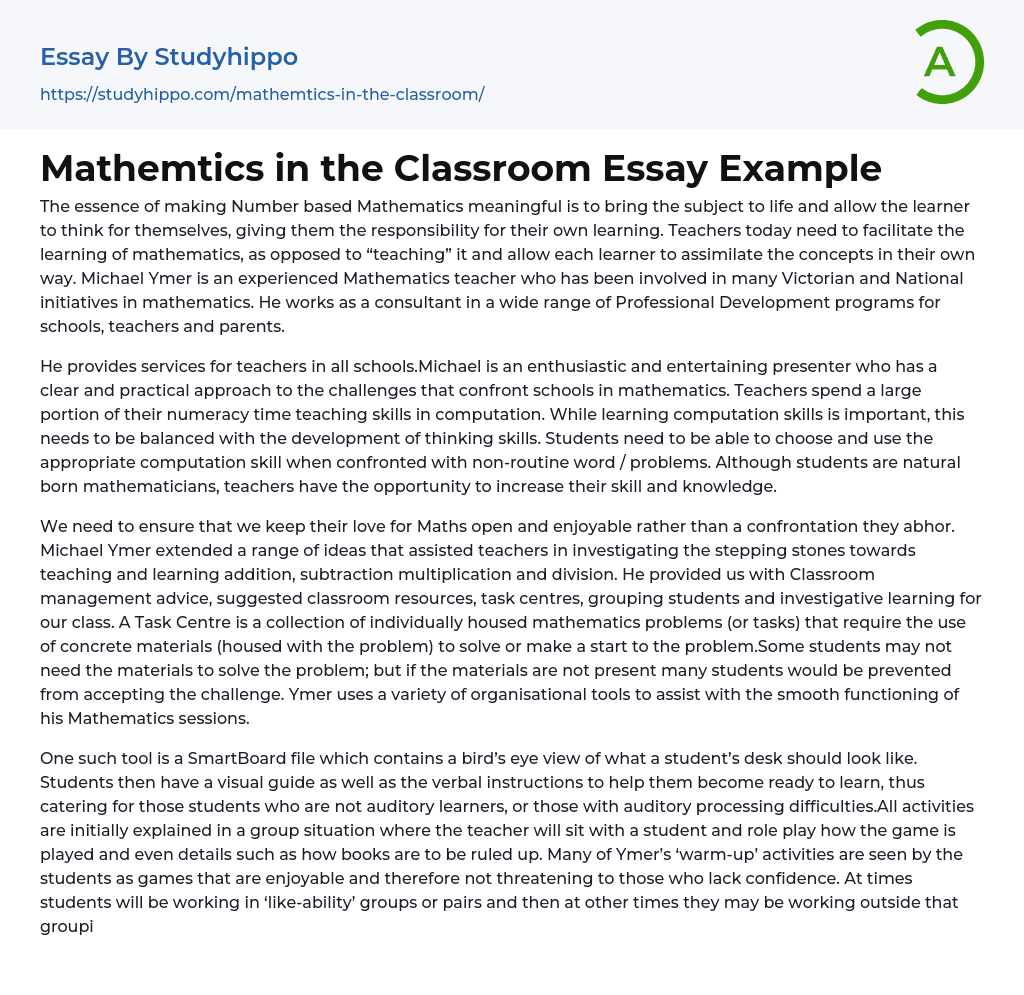To make Number based Mathematics meaningful, it is important to bring the subject to life and empower learners to take responsibility for their own learning. Instead of simply "teaching" mathematics, modern teachers should facilitate the learning process and allow each student to assimilate concepts in their own unique way. Michael Ymer, a seasoned Mathematics teacher and consultant, has contributed to numerous Victorian and National initiatives in mathematics, working with schools, teachers, and parents to lead Professional Development programs.
Michael provides services to educators in all educational institutions. He is a passionate and captivating speaker who tackles the practical issues that schools encounter when teaching mathematics. Although computation skills are significant, teachers need to balance this with fostering critical thinking abilities. It's essential for students to learn how to select and employ the appropriate computation
...skill when faced with non-standard word problems. While students have an innate talent for math, teachers can enrich their understanding and capacity via various learning opportunities.
Michael Ymer has provided teachers with valuable ideas to make the teaching and learning of addition, subtraction, multiplication, and division enjoyable and accessible to all students. To achieve this, it is crucial to avoid turning Maths into a confrontational subject that students hate. Ymer's suggestions include classroom management advice, task centres, grouping students, and investigative learning. A Task Centre is a collection of maths problems that require the use of concrete materials housed with the problem. Although some students may not need the materials to solve the problem, it is important to keep those materials available since many students require them to accept the challenge. Ymer also uses various organisational tools to ensure the smooth functioning
of his Mathematics sessions.
One tool that caters to non-auditory learners or students with auditory processing difficulties is a SmartBoard file that displays a bird's eye view of an ideal student desk. This provides students with both visual and verbal guidance to help them become ready to learn. In a group setting, activities are introduced through role-playing and instruction on details such as book ruling. Ymer's warm-up activities are presented as enjoyable games to increase confidence among students who lack it. Students may work in pairs or groups based on similarities or differences. 'Target 100' is an activity that helps struggling mathematics students improve their confidence and enjoyment by competing with higher achieving counterparts.
Ymer's activities can be customized to suit different learners. One such activity involves a combination of both luck and skill where two students compete against each other to reach as close to 100 without going over. One student deals the cards while the other student adds or multiplies them based on their level. The game continues until one student decides to stop as they cannot proceed any further without busting, and then the roles are reversed. The opposing student then attempts to beat their partner's score.
By making simple adjustments as needed, activities like 'Land Grab' can be useful. This activity focuses on arrays and multiplication, and teaches students about the Distributive and Communicative properties of multiplication in a fun and non-intimidating way. It is a great introduction to multiplication that doesn't involve putting students on the spot or causing them undue stress.
‘Land Grab’ is played by rolling 2 dice and using a piece of grid paper. One student rolls for the other
and the student doing the grabbing multiplies or uses the grid paper to determine the amount of ‘land’ they can grab. After tracing around the array on the grid sheet and writing in their table and name, they swap turns. Both students work on the same page until a time limit or the page is full, then tally up to determine the winner who grabbed the most land.
Ymer advocates for the use of technology in the classroom to facilitate the distributive property, which involves breaking up a student's array when it cannot fit. For instance, a 5 x 4 roll can be split into 3 x 4 and 2 x 4. Teachers can also modify the dice or provide reference tables to meet the students' unique requirements.
Ymer frequently incorporates the SmartBoard into his lessons and advocates for the iPhone, using it in both his Mathematics lessons and professional development sessions. As a skilled storyteller, he likes to involve his family members in the stories he tells to engage students and keep them attentive.
- Classroom Management essays
- Academia essays
- Higher Education essays
- Language Learning essays
- Studying Business essays
- Education System essays
- Study essays
- First Day of School essays
- Scholarship essays
- Pedagogy essays
- Curriculum essays
- Coursework essays
- Studying Abroad essays
- Philosophy of Education essays
- Purpose of Education essays
- Brainstorming essays
- Educational Goals essays
- Importance Of College Education essays
- Brown V Board of Education essays
- The Importance Of Higher Education essays
- Online Education Vs Traditional Education essays
- Academic And Career Goals essays
- Academic Integrity essays
- Brown Vs Board Of Education essays
- Distance learning essays
- Technology in Education essays
- Vocabulary essays
- Writing Experience essays
- Importance of Education essays
- Early Childhood Education essays
- Academic Degree essays
- Academic Dishonesty essays
- School Uniform essays
- Academic writing essays
- Cheating essays
- Bachelor's Degree essays
- MBA essays
- College Life essays
- Grade essays
- Diploma essays
- Phonology essays
- Sentence essays
- Filipino Language essays
- Pragmatics essays
- Millennium Development Goals essays
- History Of Education essays
- Graduate School essays
- Middle School essays
- School essays
- Special Education essays




